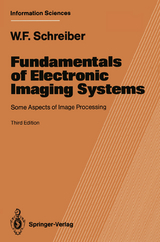Fundamentals of Electronic Imaging Systems
Springer Berlin (Verlag)
978-3-540-56018-0 (ISBN)
Dieses Buch, das sich mit der Analyse und dem Entwurf von abbildbaren Systemen und Bildverarbeitungssystemen - inklusive Fernsehen - beschäftigt, zeigt die Bedeutung mathematischer, physikalischer und perzeptorischer Phänomene. Die Kapitel "Lessons for the System Designer" sind besonders nützlich für den praktischen Gebrauch.
Image processing is a fascinating applications area, not a fundamental science of sufficient generality to warrant studying it for its own sake. In this area, there are many opportunities to apply art and experience, as well as knowledge from a number of sciences and engineering disciplines, to the creation of products and processes for which society has an expressed need. Without this need, work in the field would be sterile, but with it, image processing can readily provide the interested scientist or engineer with a professioilal lifetime of challenging problems and corresponding rewards. This point of view motivates this book and has influenced the selection and treatment of topics. I have not attempted to 1 be encyclopedic; this service has already been performed by others. It will be noted that the word "digital" is not in the title of this book. While much of present-day image processing is implemented digitally, this work is not intended for those who think of image processing as a branch of digital signal processing, except, perhaps, to try to change their minds. Image gathering and image display, vital parts of the field with strong effects on image quality, are inherently analog, as are all of the channels and media now used, or likely to be used in the future, to record TV signals and to transmit them to the home.
1. Introduction.- 1.1 What is Image Processing.- 1.2 Descriptions of Images.- 1.3 Sources and Types of Images.- 1.4 Processing Images.- 1.5 Purposes of Processing.- 1.6 Image Quality.- 1.7 A Generalized Image Processing System.- 1.8 A Simple Television System.- 1.9 Lessons for the System Designer.- 2. Light and Optical Imaging Systems.- 2.1 Light Sources.- 2.2 Photometry.- 2.3 Luminous Transfer of Simple Optical Systems.- 2.4 Some Nonideal Behavior of Simple Optical Systems.- 2.5 Fourier Optics and the Modulation Transfer Function.- 2.6 Quantum Phenomena and Related Noise Sources.- 2.7 Lessons for the System Designer.- 2.8 Appendix: Statistical Considerations.- 3. Perception of Images.- 3.1 Seeing in the Dark.- 3.2 Contrast Sensitivity.- 3.3 The Effect of Shape.- 3.4 Masking.- 3.5 Temporal Phenomena.- 3.6 Lessons for the System Designer.- 4. Sampling, Interpolation, and Quantization.- 4.1 Introduction.- 4.2 The Sampling Theorem.- 4.3 The Two-Dimensional Spectrum.- 4.4 Interpolation of Digital Images.- 4.5 The Presampling Filter.- 4.6 Hexagonal Sampling.- 4.7 Quantization.- 4.8 Lessons for the System Designer.- 5. Compression.- 5.1 Introduction.- 5.2 Information-Preserving Coding.- 5.3 Graphics Coding.- 5.4 Coding of Continuous-Tone Images.- 5.5 Lessons for the System Designer.- 6. Image Processing in the Graphic Arts.- 6.1 Introduction.- 6.2 Type Composition.- 6.3 Modern Plate Making.- 6.4 The Halftone Process.- 6.5 Lessons for the System Designer.- Color.- 7.1 Color Matching.- 7.2 Color Mixtures.- 7.3 Numerical Colorimetry.- 73.5 The Nature of the CDE Primaries.- 7.4 Other Color Spaces.- 7.5 Additive Color Reproduction.- 7.6 Subtractive Color Reproduction.- 7.7 Color Editing.- 7.8 Color Coding.- 7.9 Some Experiments in Color Perception.- 7.10 Lessons for the System Designer.- 8. The Design of Improved Television Systems.- 8.1 A Review of TV Basics.- 8.2 Relevant Psychophysics.- 8.3 The 1941 NTSC System.- 8.4 Adding Color.- 8.5 NTSC System-Design Limitations.- 8.6 Compatible Improvements to NTSC.- 8.7 Designing from Scratch.- 8.8 Desirable Characteristics of a New System.- 8.9 Channel Considerations.- 8.10 Interference Considerations.- 8.11 Video Function Characteristics Useful for System Design.- 8.12 Some Specialized Video Signal-Processing Techniques.- 8.13 Digital Terrestrial Broadcasting.- 8.14 Some Sample System Designs.- 8.15 Lessons for the System Designer.- Appendix: Development of High-Definition Television in Japan, Europe, and the United States.- A1. Introduction.- A1.1 Compatibilityz.- A1.2 Spectrum Considerations.- A1.3 Alternative Transmission Channelsx.- A1.4 Transition Scenarios.- A2. Japan.- A2.1 History of the Japanese Developments.- A2.2 The "Studio" System.- A2.3 MUSE.- A2.4 Systems Specifically Designed for US Broadcast Use.- A2.4.1 Narrow MUSE.- A2.4.2 NTSC "MUSE"-6.- A2.4.3 NTSC "MUSE"-9.- A2.5 Conclusions: Japan.- A3. The United States.- A3.1 The FCC Inquiry.- A3.2 Orginially Proposed Systems.- A3.3 The General Instrument Proposal.- A3.4 Other Digital Proposals.- A3.5 Problems of All-Digital Systems.- A3.6 Conclusions: United States.- A4. Europe.- A4.1 Multiplexed Analog Components.- A4.2 Overall European Strategy.- A4.3 Technological Approach.- A4.4 Three-Branch Motion Compensation.- A4.5 Implementation of D2-MAC and HD-MAC.- A4.6 PALplus.- A4.7 Digital Television in Europe.- A4.8 Conclusions: Europe.- A5. Overall Conclusions.- References.
| Erscheint lt. Verlag | 19.2.1993 |
|---|---|
| Reihe/Serie | Springer Series in Information Sciences |
| Zusatzinfo | XIX, 332 p. |
| Verlagsort | Berlin |
| Sprache | englisch |
| Maße | 155 x 235 mm |
| Gewicht | 610 g |
| Themenwelt | Informatik ► Theorie / Studium ► Künstliche Intelligenz / Robotik |
| Naturwissenschaften ► Physik / Astronomie ► Optik | |
| Technik ► Elektrotechnik / Energietechnik | |
| Technik ► Nachrichtentechnik | |
| Schlagworte | Apertur • Bildverarbeitung • Computergraphik • Digitale Bildverarbeitung • Elektronik • Entropy • Graphic arts • Image Processing • Image Processing System • Imaging • Information • Interpolation • Modulation • Orthogonal Frequency-Division Multiplexing (OFDM) • Springer Series in Information Sciences; Vol 15 • Standards • Systems Theory • Television • Transmission |
| ISBN-10 | 3-540-56018-1 / 3540560181 |
| ISBN-13 | 978-3-540-56018-0 / 9783540560180 |
| Zustand | Neuware |
| Haben Sie eine Frage zum Produkt? |
aus dem Bereich




